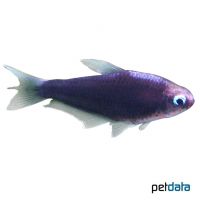Black Emperor Tetra (Nematobrycon palmeri 'Black')
| Black Emperor Tetra Nematobrycon palmeri 'Black' | |
|---|---|
| Name | Black Emperor Tetra |
| Name Lat. | Nematobrycon palmeri 'Black' |
| Family | Characins |
| Family lat. | Characidae |
| Order | Characins |
| Order lat. | Characiformes |
| Origin | Colombia (breeding variety) |
| Habitat | Rivers, tributaries |
| Diet | Carnivore |
| pH | 5.0-7.5 |
| Behavior | Peaceful |
| Keeping | Group |
| Care Level | Moderate |
| Reproduction | Egg scatterer |
| Breeding | Moderately difficult |
| Life Span | 4-6 years |
| Protection | No |
| Metric Units | |
| Size | 4-5 cm |
| Temperature | 23-27 °C |
| Hardness | 1-12 °dH |
| Aquarium | ~ 100 l |
| US Units | |
| Size | 1.6"-2" |
| Temperature | 73-81 °F |
| Hardness | 18-214 ppm |
| Aquarium | ~ 25 gal |
Distribution and habitat
The black emperor tetra is a breeding form. The emperor tetra is native in Colombia in the Rio Atrato and the Rio San Juan as well as in their tributaries. They prefer to live in the slow-flowing sections of the rivers and in their stillwaters.
Maintenance
The aquarium should have a varied, partly dense planting, with shelters and hiding places (roots) and provide sufficient swimming space. A dark substrate covered with some foliage (e.g. sea almond leaves), shaded light (floating plants) and a weak current is ideal.
No ammonia, ammonium and nitrite should be detectable, the nitrate value should not exceed 100 mg/l. To ensure the water quality and oxygen content, a filter and heater adapted to the aquarium size is required, as well as lighting for the species-appropriate day-night rhythm of the animals.
Diet
In nature they feed mainly on small insects and larvae. The food supply consists of live, frozen and dry food. For a balanced diet, feed once a day with a high-quality, protein-rich dry food (flakes, granules, pellets) as well as cyclops, moina, daphnia, artemia, etc. (live or frozen)
It is recommended to feed small portions several times a day. Only feed as much as will be eaten within a few minutes. A regular and varied diet promotes health and increases resistance.
Behaviour and compatibility
They are lively fish that can be kept well in a community tank. Males will defend territories against conspecifics at least some of the time. At least 5, but preferably more Emperor Tetra should be kept together, with the number of females predominating.
In principle, only mutually compatible fish species with similar requirements to the water condition and water temperature may be socialized.
Sex dimorphism
The males are larger, more strongly colored and have a distinctly extended dorsal fin. The males have a blue iris, in the females it is green.
Reproduction and breeding
They are free spawners that spawn in soft, slightly acidic peat water usually between fine-feathered plants. The larvae hatch after 24-36 hours and swim freely after 4-5 days. The parents do not engage in brood care and should be separated from the fry after spawning, as they are spawn predators.
Fry must be fed several times a day with special rearing food (Artemia nauplii). Breeding is hardly possible in community tanks, as the spawn is easy prey.
Important
The emperor tetra is occasionally confused with the rainbow tetra (Nematobrycon lecontei). One distinguishing feature is the iris of the males. In the emperor tetra male (Nematobrycon palmeri) the iris is blue, in the rainbow tetra male (Nematobrycon lecontei) the iris is red.
The well-being of the fish should be checked regularly. Temperature should be checked daily, pH, hardness and nitrate levels should be checked at least every 14 days. Regular partial water changes are recommended, even if the contaminant level has not yet reached the upper limit. Sudden changes in water quality should be avoided. Newly introduced fish must be accustomed slowly to the water in the aquarium.
Further literature can be found in your pet store.
References
Text: petdata; Image: petdata
Source: BMEL (1998): Tierschutzgutachten - Haltung von Zierfischen (Süßwasser); RIEHL & BAENSCH (2006): Aquarien Atlas Bd. 1, Mergus Verlag; ENGELMANN (2005): Zootierhaltung - Tiere in menschlicher Obhut: Fische, Verlag Harri Deutsch
- Gemäß § 21 Abs. 5 Tierschutzgesetz idgF
